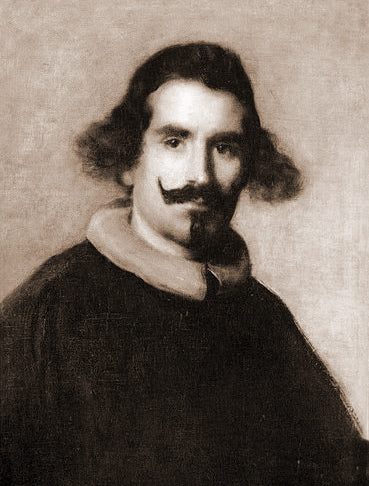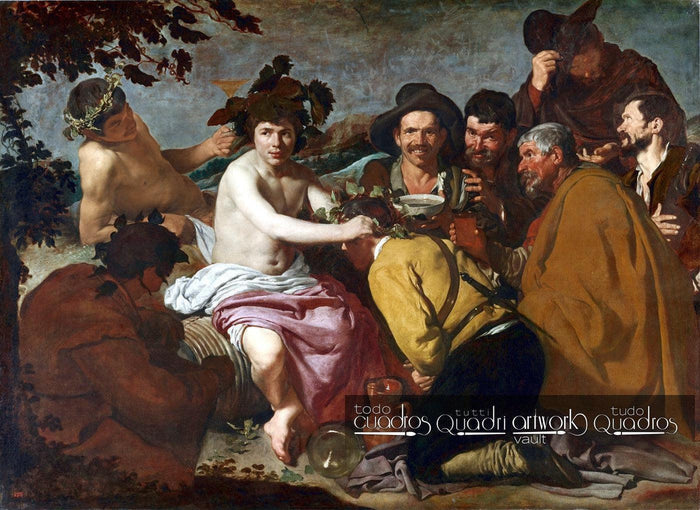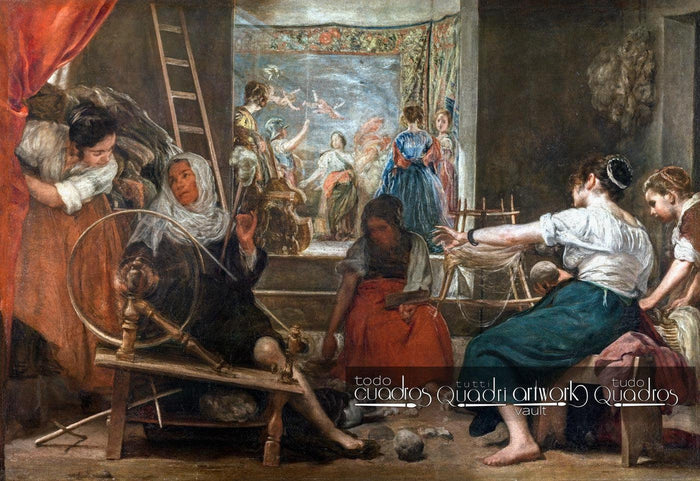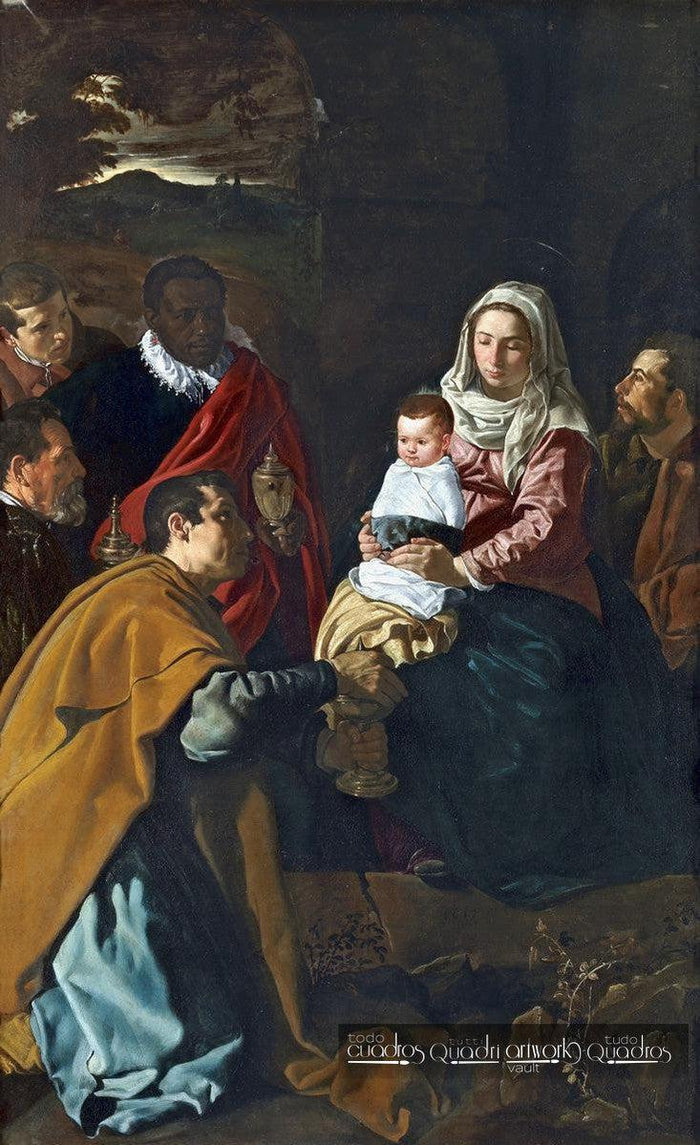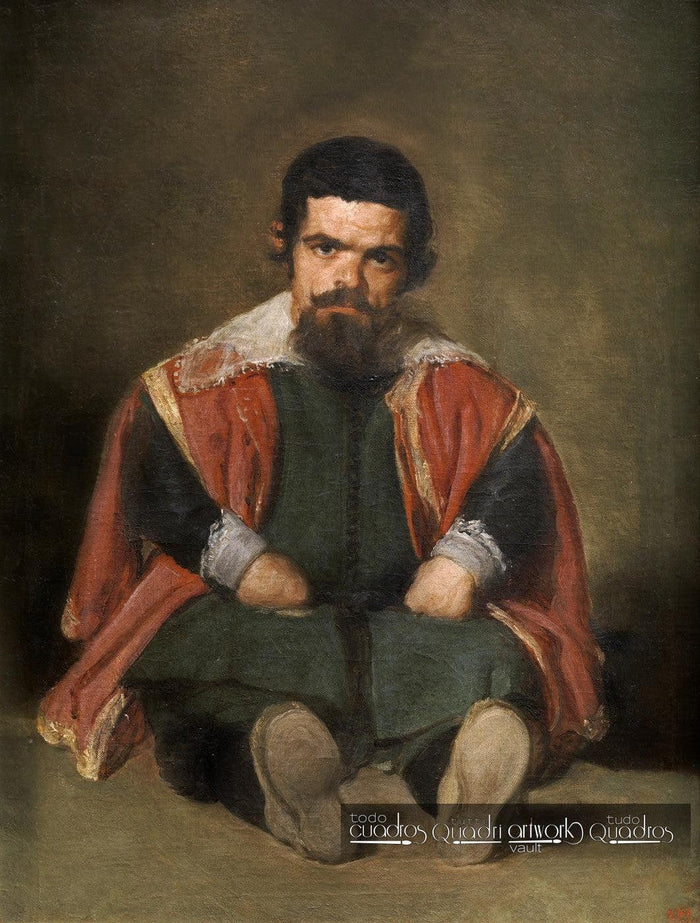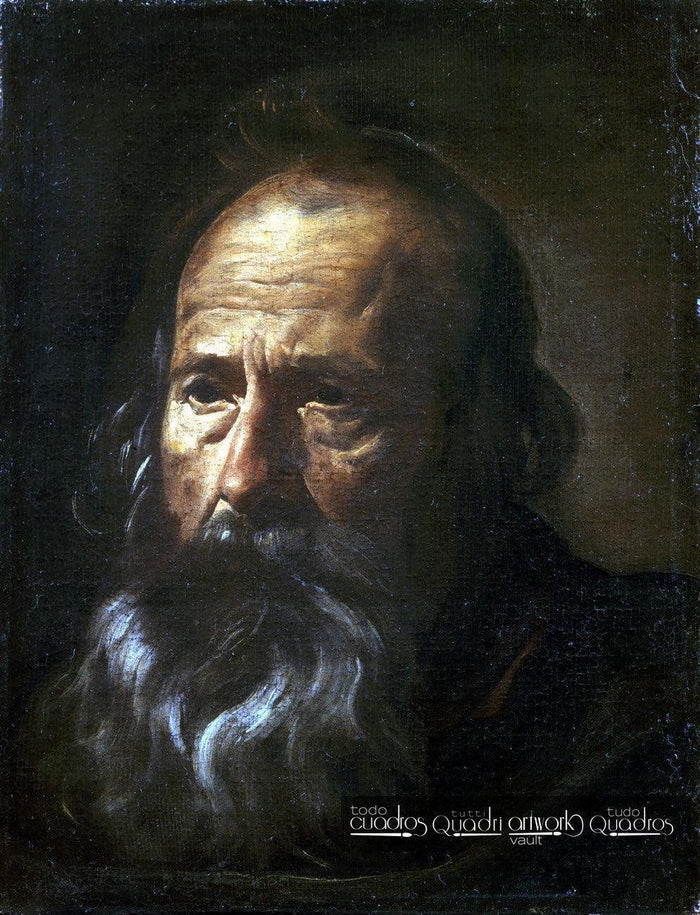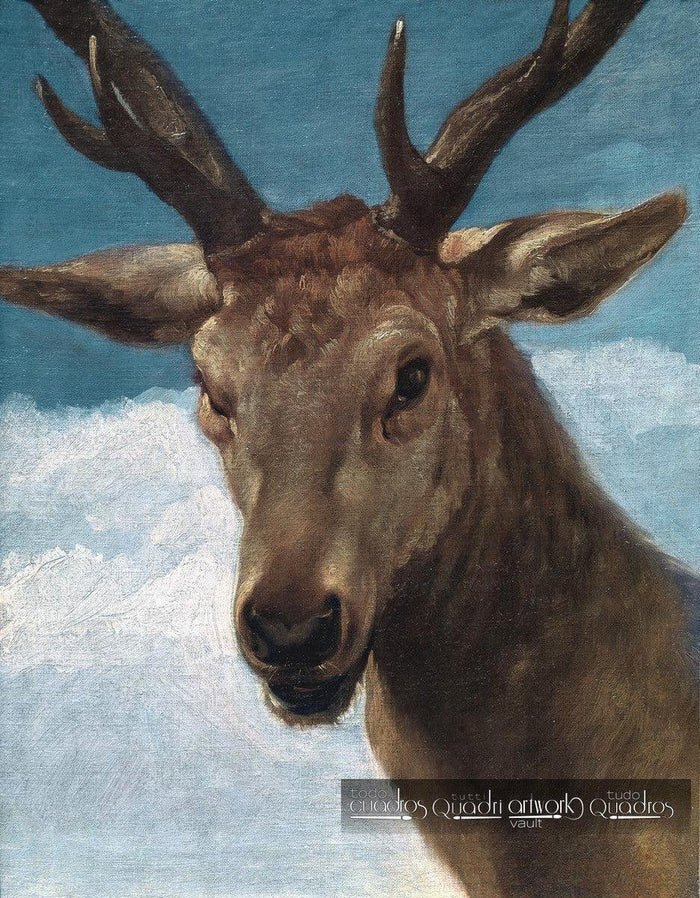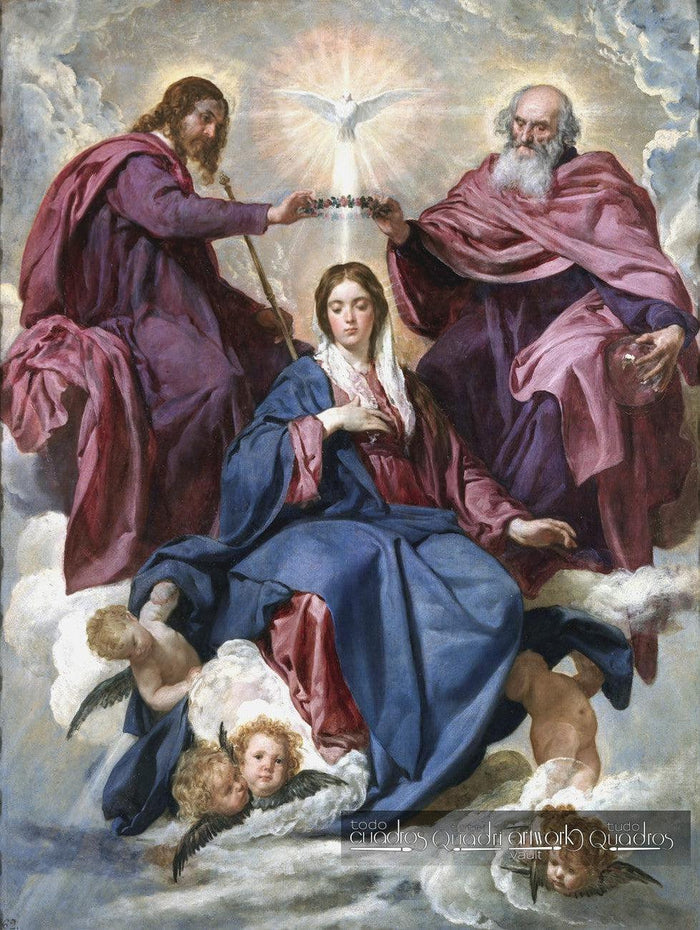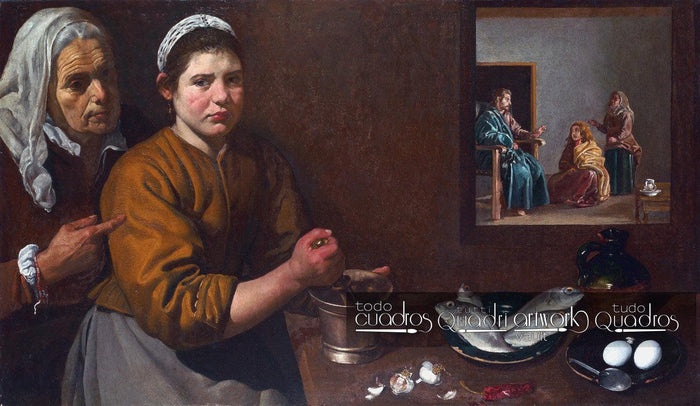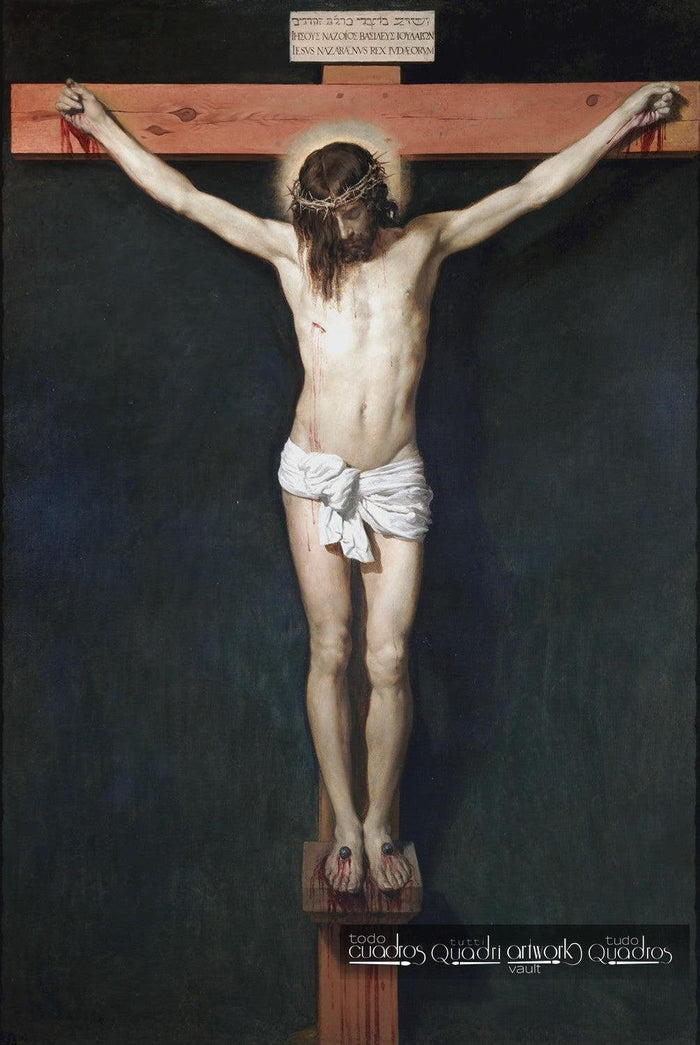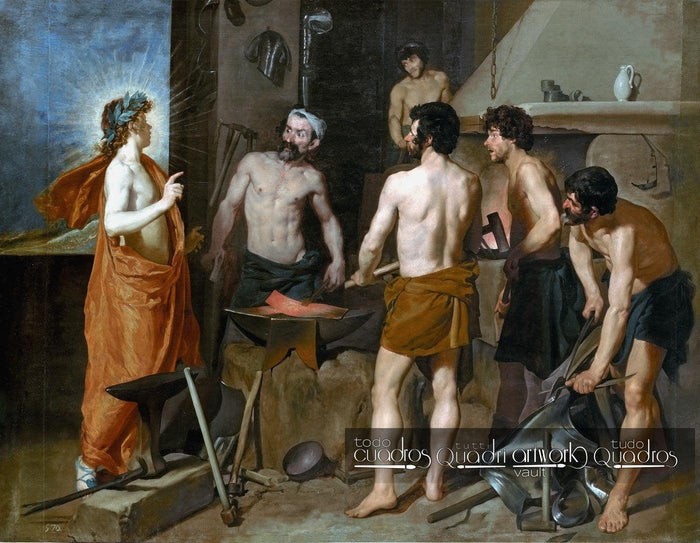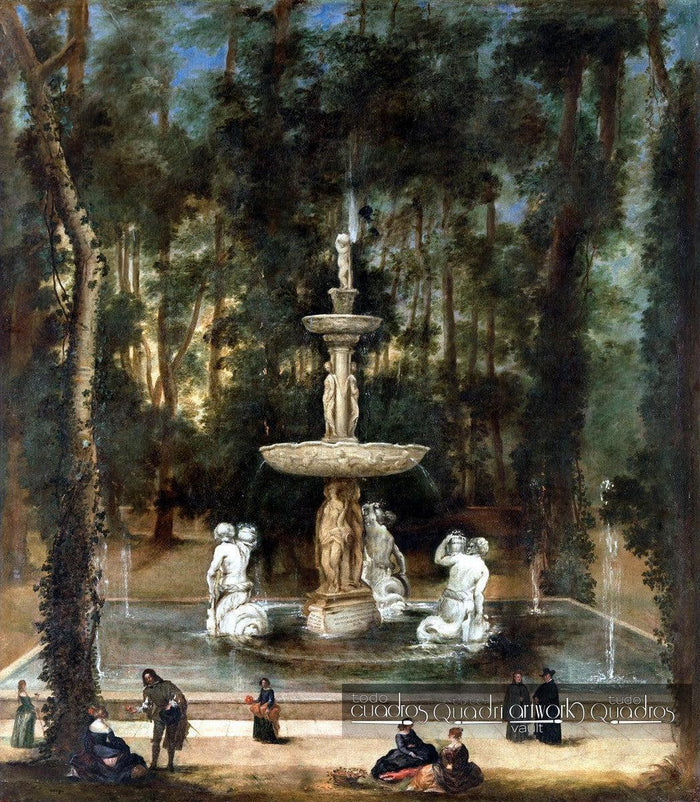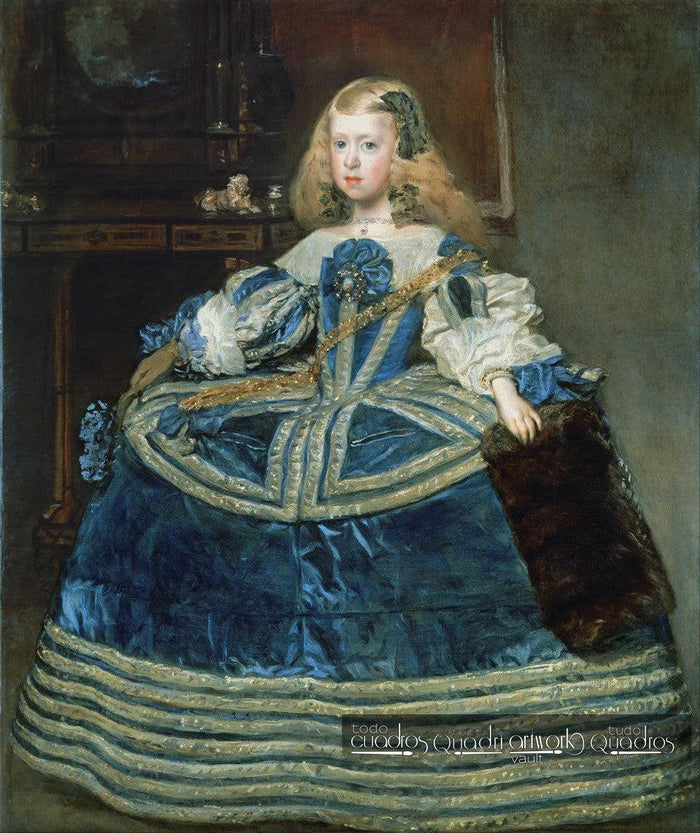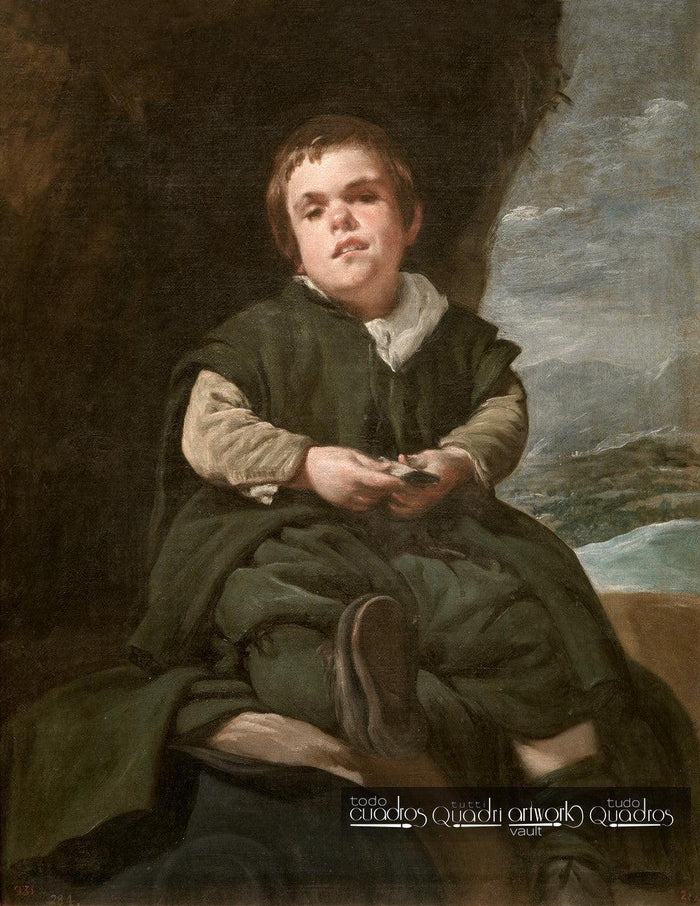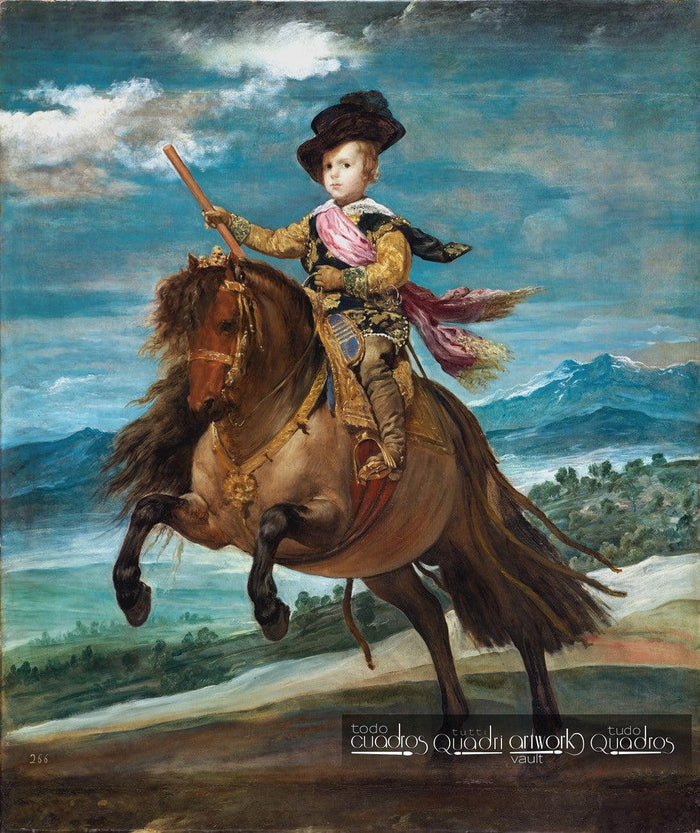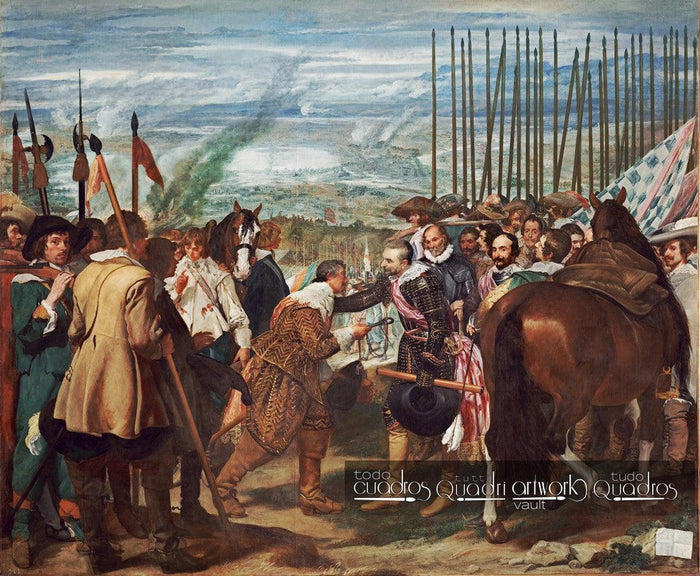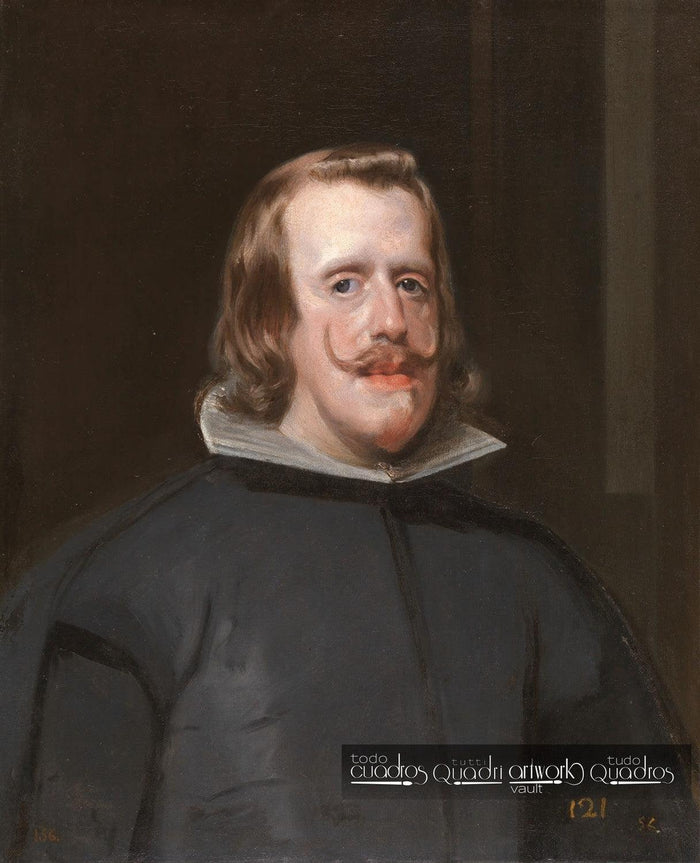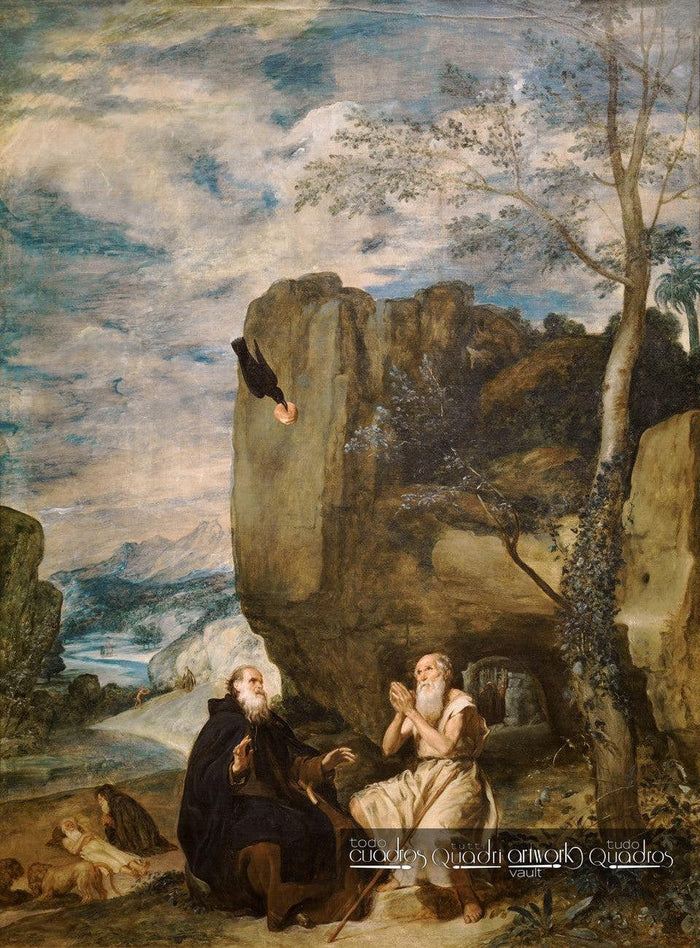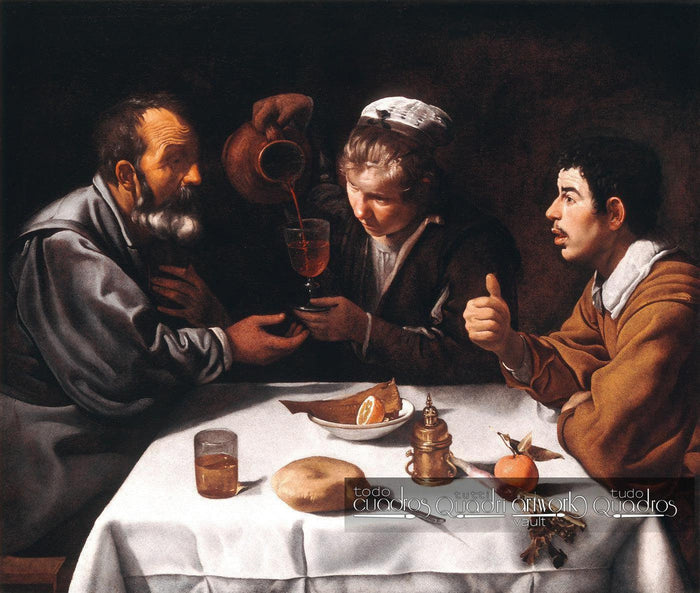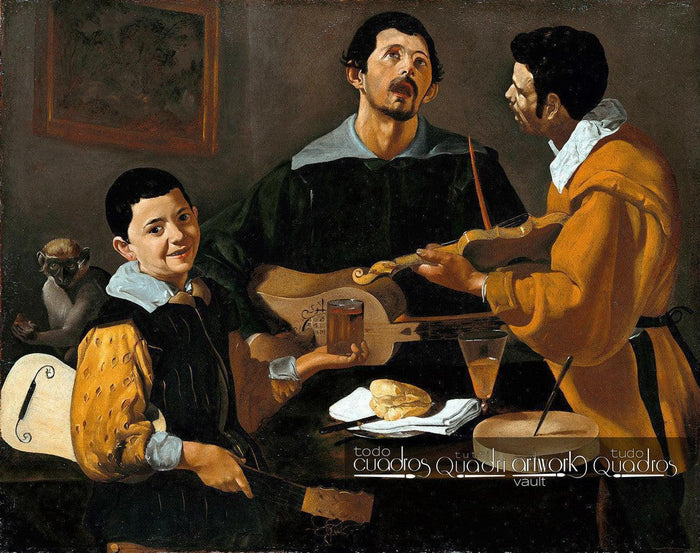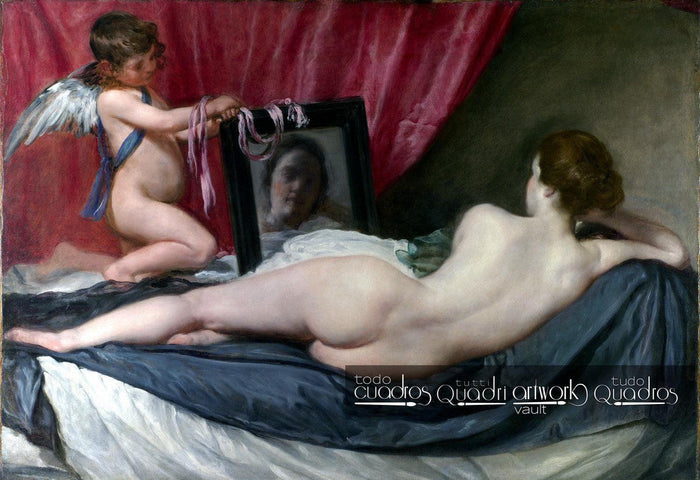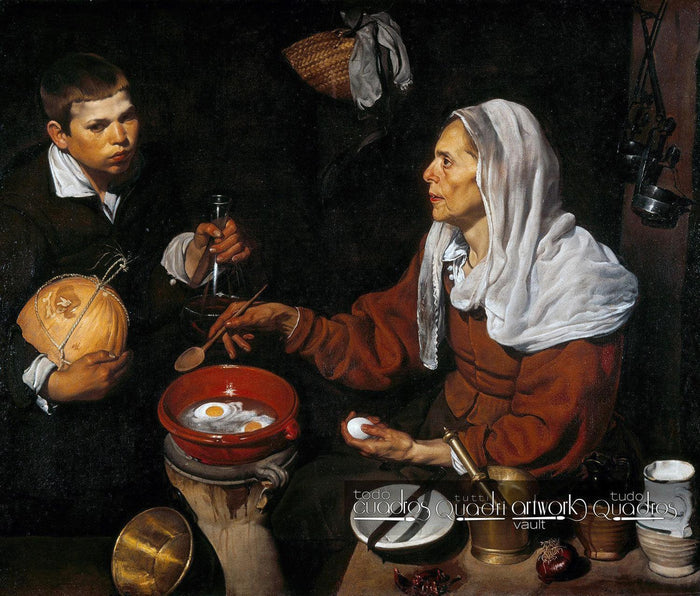Velázquez Paintings
Today, around 130 paintings with certified authorship by Diego Velázquez are preserved, and here we present the 22 most significant ones.
1. Las Meninas
| Author: | Diego Velázquez |
|---|---|
| Original Title: | Las meninas |
| Type: | Painting |
| Style: | Baroque |
| Medium | Oil |
| Support: | Canvas |
| Year: | 1656 |
| Genre: | Period scene |
| Located: | Prado National Museum, Madrid. |
Las Meninas (1656) is the undisputed masterpiece of Velázquez and one of the most analyzed and admired compositions in the entire history of Western art. Painted during his tenure as court painter to Philip IV, this monumental work offers a complex reflection on representation, power, and perception. The central figure is the Infanta Margarita Teresa of Austria, surrounded by her ladies-in-waiting, known as “meninas,” along with jesters, a mastiff, and the artist himself, who includes his own self-portrait while working before the viewer.
Read more2. The Feast of Bacchus
| Author: | Diego Velázquez |
|---|---|
| Original Title: | El triunfo de Baco |
| Type: | Painting |
| Style: | Baroque |
| Medium | Oil |
| Support: | Canvas |
| Year: | 1628 |
| Subject: | Classical Mythology |
| Located: | Prado National Museum, Madrid. |
The Triumph of Bacchus (1628–1629), also known as "The Drunks", is a key work in Velázquez’s technical evolution. It demonstrates his exceptional mastery of chiaroscuro and light modulation: a lateral light subtly models the volumes, highlights the body of Bacchus, and creates a warm atmosphere where ochres, earth tones, and grays are balanced with pink and golden accents. The brushwork, still controlled yet vibrant, combines anatomical precision with optical naturalism, foreshadowing the painter’s stylistic maturity.
Read more3. The Fable of Arachne
| Author: | Diego Velázquez |
|---|---|
| Original Title: | Las hilanderas o la fábula de Aracne |
| Type: | Painting |
| Style: | Baroque |
| Medium | Oil |
| Support: | Canvas |
| Year: | 1657 |
| Subject: | Literary scene |
| Located: | Prado National Museum, Madrid. |
The Fable of Arachne (circa 1657), also known as "The Spinners", is one of Velázquez’s most ambitious and enigmatic compositions. Considered, along with Las Meninas, the culmination of his art, this work combines technical virtuosity, spatial complexity, and profound intellectual depth. Its scenographic structure, articulated in two planes of action, reveals an exceptional mastery of light, movement, and atmospheric perspective.
Read more4. Adoration of the Magi
| Author: | Diego Velázquez |
|---|---|
| Original Title: | Adoration of the Magi |
| Type: | Painting |
| Style: | Baroque |
| Medium | Oil |
| Support: | Canvas |
| Year: | 1619 |
| Subject: | Biblical passage |
| Located: | Prado National Museum, Madrid. |
In The Adoration of the Magi, Velázquez naturally portrays the moment when the three kings from the East offer their gifts to the Infant Jesus. The scene unfolds in a simple, unadorned setting, where the light emphasizes the encounter between the figures and creates an atmosphere of calm and contemplation. The arrangement of the figures forms a visual circle that draws the viewer’s attention toward the child, the true center of the composition.
Read more5. Portrait of Sebastián de Morra
| Author: | Diego Velázquez |
|---|---|
| Original Title: | El bufón el Primo |
| Type: | Painting |
| Style: | Baroque |
| Medium | Oil |
| Support: | Canvas |
| Year: | 1644 |
| Genre: | Retrato |
| Located: | Prado National Museum, Madrid. |
Also known as: "The Buffoon El Primo".
During his career, Velázquez created numerous portraits of dwarf jesters; this is considered the most brilliant work on the subject. The technical characteristics, colors, lighting, and anatomical description are nearly perfect.
Another famous dwarf portrait by Velázquez is the child of Vallecas.
6. Apostle’s Head
| Author: | Diego Velázquez |
|---|---|
| Original Title: | Apostle’s Head |
| Type: | Painting |
| Style: | Baroque |
| Medium | Oil |
| Support: | Canvas |
| Year: | 1620 |
| Genre: | Retrato |
| Located: | Prado National Museum, Madrid. |
This portrait features a remarkable use of chiaroscuro, showcasing the face of an apostle. It is not exactly known which biblical figure it represents, but it is known not to be either Saint Thomas or Saint Paul, as it is presumed that the original canvas (before being trimmed) already included these two saints.
Experts are not 100% certain of the canvas's authorship; however, the characteristics of the painting can be attributed with little margin of error to the style the painter developed between 1619 and 1620.
Read more7. Head of a Deer
| Author: | Diego Velázquez |
|---|---|
| Original Title: | Head of a Deer |
| Type: | Painting |
| Style: | Baroque |
| Medium | Oil |
| Support: | Canvas |
| Year: | 1626-1636 |
| Genre: | Retrato |
| Located: | Prado National Museum, Madrid. |
Although its authorship is not 100% confirmed, most experts agree that the brushstrokes and technique used match the stylistic approach of the painter.
8. The Coronation of the Virgin
| Author: | Diego Velázquez |
|---|---|
| Original Title: | La coronación de la Virgen |
| Type: | Painting |
| Style: | Baroque |
| Medium | Oil |
| Support: | Canvas |
| Year: | 1636 |
| Genre: | Religious paintings |
| Located: | Prado National Museum, Madrid. |
It is considered one of the most significant religious works by Velázquez. The painting was created for the private chapel of Queen Consort Isabel de Borbón, in the Royal Alcázar of Madrid. This context explains the delicacy of the theme and the symbolic depth with which the artist approaches the subject, conceived as an allegory of virtue and divine authority. A connection can be perceived between the figure of Isabel and the central motif of the painting, in which the Virgin Mary assumes a role of spiritual sovereignty, reflecting the queen’s earthly royalty.
Read more9. Christ in the House of Martha and Mary
| Author: | Diego Velázquez |
|---|---|
| Original Title: | Christ in the House of Martha and Mary |
| Type: | Painting |
| Style: | Baroque |
| Medium | Oil |
| Support: | Canvas |
| Year: | 1618 |
| Subject: | Biblical passage |
| Located: | National Gallery, Londres. |
A biblical scene from the early artistic period of Velázquez. As often happens in Baroque painting, the main scene is depicted in the background, showing Jesus speaking with the sisters Martha and Mary. The characters in the foreground: the elderly woman and the servant, do not belong to the gospel text.
Fifty years later, J. Vermeer painted his own version of the biblical passage.
10. The Crucified Christ
| Author: | Diego Velázquez |
|---|---|
| Original Title: | The Crucified Christ |
| Type: | Painting |
| Style: | Baroque |
| Medium | Oil |
| Support: | Canvas |
| Year: | 1632 |
| Genre: | Religious paintings |
| Located: | Prado National Museum, Madrid. |
Considered one of the most sublime representations of the Crucified Christ in the history of Western art, this work by Diego Velázquez unites the precision of naturalism with profound spiritual depth. Recognized as a masterpiece of male anatomy, its balance between formal beauty and inner drama has inspired generations of artists and writers. The serenity of the scene, stripped of any superfluous detail, focuses attention on the central figure and transforms suffering into a gesture of solemn stillness. The composition evokes Psalm 45, verse 3: “You are fairer than the sons of men; grace is poured upon your lips; therefore God has blessed you forever.”
Read more11. Vulcan's Forge
| Author: | Diego Velázquez |
|---|---|
| Original Title: | Vulcan's Forge |
| Type: | Painting |
| Style: | Baroque |
| Medium | Oil |
| Support: | Canvas |
| Year: | 1630 |
| Subject: | Classical Mythology |
| Located: | Prado National Museum, Madrid. |
This is one of the most elaborate works and the first in which the painter addressed a mythological theme.
The canvas depicts the Greek god Apollo visiting the forge run by the god Vulcan to inform him that Venus, his wife, has betrayed him with Mars, who is astonished by Apollo's words.
The composition and finely achieved anatomical proportions are characteristic of the Italian school, learned by Velázquez during his stay in Rome.
The painting was created from a costumbrista (costumbrist) perspective, this can be seen in the absence of glows on the god Vulcan and the replacement of the cyclopes, who are the original assistants of the god-smith, by four young men. Diego Velázquez seeks to bring this scene down from Olympus to make it closer to the people, presenting it also as a moment of natural life.
12. The Fountain of the Tritons in the Island Garden of Aranjuez
| Author: | Diego Velázquez |
|---|---|
| Original Title: | La Fuente de los Tritones en el Jardín de la Isla de Aranjuez |
| Type: | Painting |
| Style: | Baroque |
| Medium | Oil |
| Support: | Canvas |
| Year: | 1657 |
| Genre: | Landscape |
| Located: | Prado National Museum, Madrid. |
This rural landscape depicts the famous Fountain of the Tritons, a white marble sculpture that is still preserved today and currently stands on one side of the Royal Palace of Madrid. When Diego Velázquez painted this canvas, around the mid-17th century, the fountain —by an unknown artist— was located in the gardens of the Royal Site of Aranjuez, a place that inspired the painter for its natural atmosphere and architectural harmony. It was relocated to its current position in the 19th century.
Read more13. Infanta Margarita Teresa in a Blue Dress
| Author: | Diego Velázquez |
|---|---|
| Original Title: | Infanta Margarita Teresa in a Blue Dress |
| Type: | Painting |
| Style: | Baroque |
| Medium | Oil |
| Support: | Canvas |
| Year: | 1659 |
| Genre: | Retrato |
| Located: | Vienna Museum of Art History |
This is one of the most renowned personal portraits by the artist, depicting Infanta Margaret Theresa of Spain at the age of eight, the beloved daughter of Philip IV of Spain, and the subject of the canvas Las Meninas. Fascinating, this masterpiece by Diego Velázquez, intended for Austria in 1659, is a gem of the Baroque and a visionary precursor to French Impressionism that would emerge two hundred years later. The artist's skill in playing with thick brushstrokes transforms the infanta's dress into a visual enigma that, up close, challenges our perception. From a distance, the viewer is immersed in a world of exquisite textures: velvet, linen, thread lace, and delicate skin. The masterful lighting of the face against a dark background adds depth and volume that invite contemplation. Velázquez does not just paint; he orchestrates a sublime concert of styles, textures, and volumes, enriching the aesthetic experience and elevating it to the next level of beauty.
Read more14. The Boy from Vallecas (Francisco Lezcano)
| Author: | Diego Velázquez |
|---|---|
| Original Title: | El Niño de Vallecas |
| Type: | Painting |
| Style: | Baroque |
| Medium | Oil |
| Support: | Canvas |
| Year: | 1635-1645 |
| Genre: | Retrato |
| Located: | Prado National Museum, Madrid. |
The portrait of Francisco Lezcano, known as "The Boy from Vallecas," is one of Velázquez’s most remarkable works within his series of jesters and attendants of the court of Philip IV. Lezcano, who suffered from an intellectual disability—described at the time as “oligophrenia”—served as jester to Prince Balthasar Charles. The artist depicts him seated in a pastoral setting with a marine background, far removed from any theatricality, his expression calm yet slightly proud. He holds in his hands a deck of cards, a symbol of leisure, chance, or the role fate assigned him at court. The concentrated light on his face and hands, combined with the sobriety of the rest of the composition, lends the portrait a human depth that transcends his social and physical condition.
Read more15. Equestrian Portrait of Prince Balthasar Charles
| Author: | Diego Velázquez |
|---|---|
| Original Title: | El príncipe Baltasar Carlos, a caballo |
| Type: | Painting |
| Style: | Baroque |
| Medium | Oil |
| Support: | Canvas |
| Year: | 1635 |
| Genre: | Retrato |
| Located: | Prado National Museum, Madrid. |
Portrait of a child with a horse, Prince Baltasar Carlos (1629-1646), son of Philip IV. The painting was intended to promote the authority of the future king, who already posed in the style of his father and grandfather. Hence, the scepter in his right hand and the military attire, even as a child.
The background landscape indicates that the character is located in El Pardo (town of Madrid). The view is directed towards the mountains of the Sierra de Hoyo de Manzanares.
Painting also known as Prince Baltasar Carlos on Horseback.
16. The Surrender of Breda
| Author: | Diego Velázquez |
|---|---|
| Original Title: | Las lanzas |
| Type: | Painting |
| Style: | Baroque |
| Medium | Oil |
| Support: | Canvas |
| Year: | 1635 |
| Located: | Prado National Museum, Madrid. |
A historic military moment that highlights the victory of Philip IV's Spanish army over the landlords in the Netherlands. The friendly gesture of the characters reflects the terms on which the dispute was settled: a surrender considered honorable by Spain.
This work by Diego is also very well-known as The Lances (in Spanish, Las lanzas).
17. Philip IV of Spain
| Author: | Diego Velázquez |
|---|---|
| Original Title: | Philip IV of Spain |
| Type: | Painting |
| Style: | Baroque |
| Medium | Oil |
| Support: | Canvas |
| Year: | 1656 |
| Genre: | Retrato |
| Located: | Prado National Museum, Madrid. |
Philip IV (1605–1665) was the monarch most frequently portrayed by Velázquez. This particular work depicts the king at the age of 52 and is one of the most renowned for its clean composition, realism, and vitality. By the same artist, an almost identical painting can be found at the National Gallery in London.
18. Saints Anthony Abbot and Paul the Hermit
| Author: | Diego Velázquez |
|---|---|
| Original Title: | saints-anthony-abbot-paul-hermit |
| Type: | Painting |
| Style: | Baroque |
| Medium | Oil |
| Support: | Canvas |
| Year: | 1634 |
| Genre: | Religious paintings |
| Located: | Prado National Museum, Madrid. |
The painting depicts three episodes from the “Golden Legend” by Santiago de la Vorágine (1230–1298), focusing on Saint Anthony Abbot and Saint Paul the Hermit. At the center, the two saints meet in a rocky landscape—Anthony dressed in brown and Paul in white—while a raven descends carrying the bread that symbolizes divine providence. On either side, Velázquez includes two complementary scenes: on the left, the burial of Saint Paul assisted by a lion; on the right, the discovery of the hermit dead in prayer. The composition maintains a narrative and spiritual balance, uniting the three moments into a single harmonious vision.
Read more19. Tavern Scene with Two Men and a Girl
| Author: | Diego Velázquez |
|---|---|
| Original Title: | Almuerzo de campesinos |
| Type: | Painting |
| Style: | Baroque |
| Medium | Oil |
| Support: | Canvas |
| Year: | 1618–1619 |
| Located: | Hermitage Museum, St. Petersburg |
A work of Sevillian genre painting, also known as The Farmers' Lunch or Peasants at the Table, where the artist depicts three men of different generations joyfully sharing a meal. In the dim light, a servant pours wine to continue the evening.
20. Three Musicians
| Author: | Diego Velázquez |
|---|---|
| Original Title: | Three Musicians |
| Type: | Painting |
| Style: | Baroque |
| Medium | Oil |
| Support: | Canvas |
| Year: | 1618 |
| Genre: | Costumbrism |
| Located: | Berlin Gemäldegalerie Art Gallery |
Set in Seville, this genre scene aims to highlight the sordid nature of the situation: the youngest of the men, with a mocking expression, holds a glass of wine, indicating that the three musicians have already been drinking. The two characters on the right hold their instruments loosely and seem to be playing music that is disjointed and tuneless.
The preservation of the artwork is exceptional, with the colors, figures, and lighting remaining almost unchanged to this day.
21. The Toilet of Venus ('The Rokeby Venus')
| Author: | Diego Velázquez |
|---|---|
| Original Title: | La Venus del espejo |
| Type: | Painting |
| Style: | Baroque |
| Medium | Oil |
| Support: | Canvas |
| Year: | 1649 |
| Subject: | Classical Mythology |
| Located: | National Gallery, Londres. |
This canvas, known as “The Rokeby Venus”, is the only surviving female nude by the painter. Velázquez displays an absolute mastery of diffused light and tonal modeling, reaching one of the highest achievements of Baroque naturalism. The composition is organized through gentle diagonals that guide the viewer’s gaze from the curves of the body toward the mirror, integrating figure and space into a perfect visual unity. The restricted palette—pearl gray, pink, brown, and white—creates an intimate and silent atmosphere. The skin is built up through translucent glazes that soften the contours, producing a luminous and lifelike texture, while the folds of the fabrics are rendered with freer, more vibrant brushwork. The contrast between the anatomical clarity of the body and the blurriness of the reflection introduces a dialogue between reality and representation, body and appearance, anticipating a surprising modernity in Velázquez’s art.
Read more22. Old Woman Frying Eggs
| Author: | Diego Velázquez |
|---|---|
| Original Title: | Vieja friendo huevos |
| Type: | Painting |
| Style: | Baroque |
| Medium | Oil |
| Support: | Canvas |
| Year: | 1618 |
| Genre: | Costumbrism |
| Located: | National Gallery of Scotland |
Old Woman Frying Eggs is one of Velázquez’s earliest masterpieces, painted during his youth in Seville and regarded as a benchmark of 17th-century Spanish costumbrismo.
The work dazzles with the extraordinary precision with which Velázquez captures a wide variety of materials and textures: the sheen of the boiling oil, the weight of the bronze mortar, the roughness of the fabrics and vegetables, the wear marks on the kitchen utensils, the dark wood, the metals, the ceramics, and the wicker. Each element appears carefully arranged, not as mere decoration, but as an exercise in observation and technical virtuosity.
Read moreOrder it in the section: Velázquez oil paintings
Related famous painters:
- El Greco
- Francisco de Goya
- Peter Paul Rubens
- Rembrandt
- Salvador Dalí
- Leonardo da Vinci
- Bartolomé Esteban Murillo
↑Back to top
